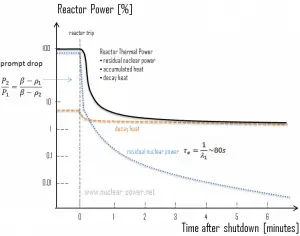 Methods for removing decay or residual heat from a reactor core can be grouped into two general categories:
Methods for removing decay or residual heat from a reactor core can be grouped into two general categories:
- Closed-Loop System. One category includes methods that circulate fluid through the reactor core in a closed-loop, using some type of heat exchanger to transfer heat out of the system.
- Heat Removal through Steam Generators. Steam generators can be used to remove decay heat from a reactor, and they dissipate heat directly to the main condenser or the atmospheric steam dump system. In this operational mode, some reactor coolant pumps (RCPs) must usually be in operation, or natural circulation must have remained.
- Heat Removal through RHR. The residual heat removal system (RHR) is a low-pressure heat removal system. PWRs take water from one or two RCS hot legs, cool it in RHR heat exchangers, and pump it back to the cold legs or core flooding tank nozzles. To accomplish RHR heat removal, RHR heat exchangers transfer heat to the component cooling water or service water system, which then transports heat to the ultimate heat sink (UHS).
- Open System: The other category includes methods that operate in an open system, drawing in cool fluid from some source and discharging warmer fluid to some storage area or the environment.
- Decay heat removal using the feed-and-bleed method. The feed-and-bleed method for decay heat removal becomes a necessary method in some pressurized water reactors (PWRs) if there is a loss of steam generator heat sink capability. The feed-and-bleed technique involves passing hot coolant out of the primary system through a pilot-operated relief valve (PORV). The primary system is fed with subcooled coolant through a high-pressure safety injection system (HPSI), part of the emergency core cooling system.